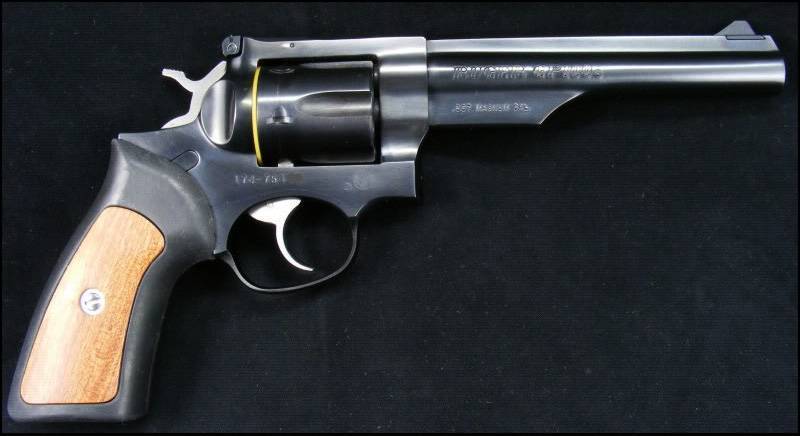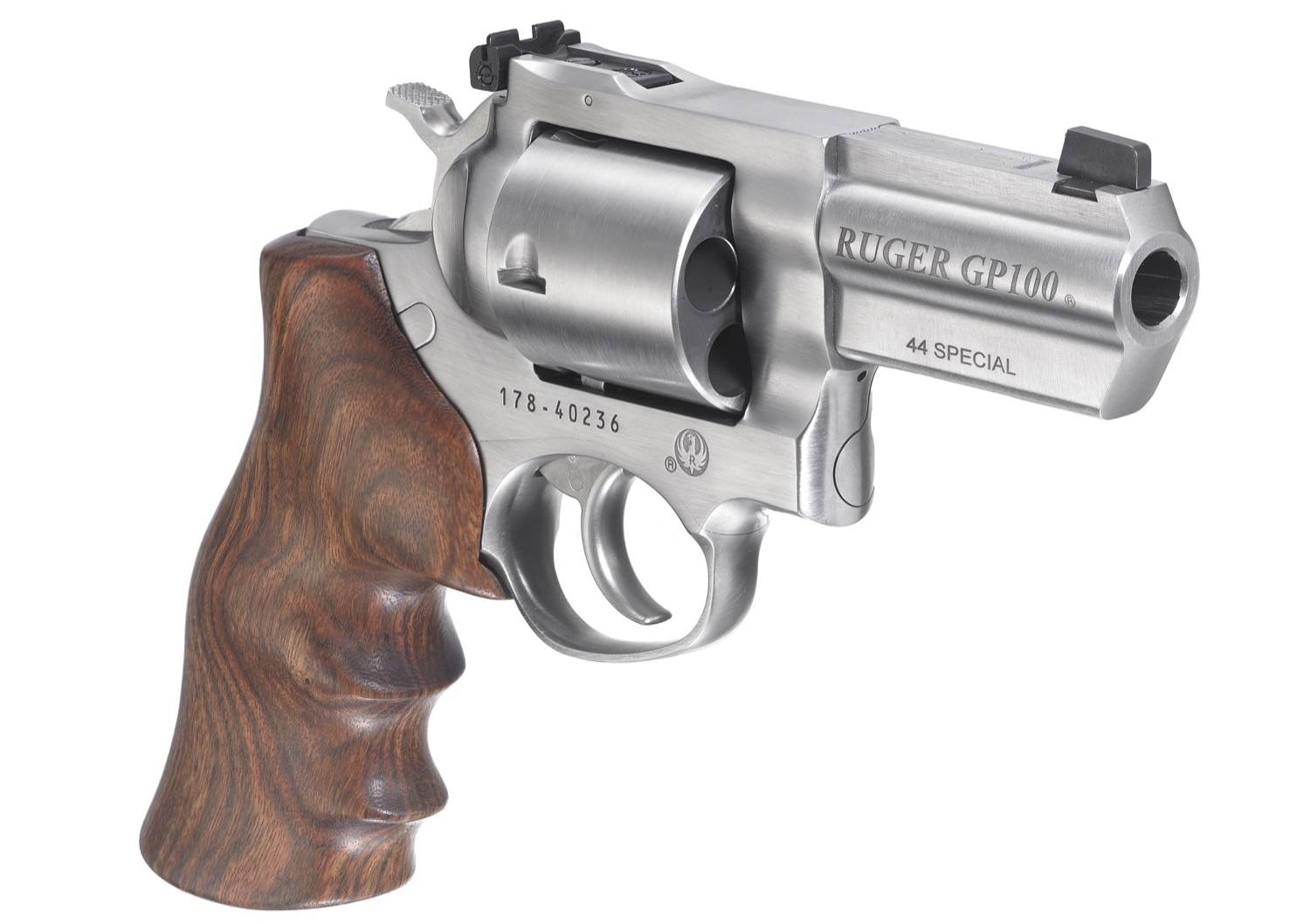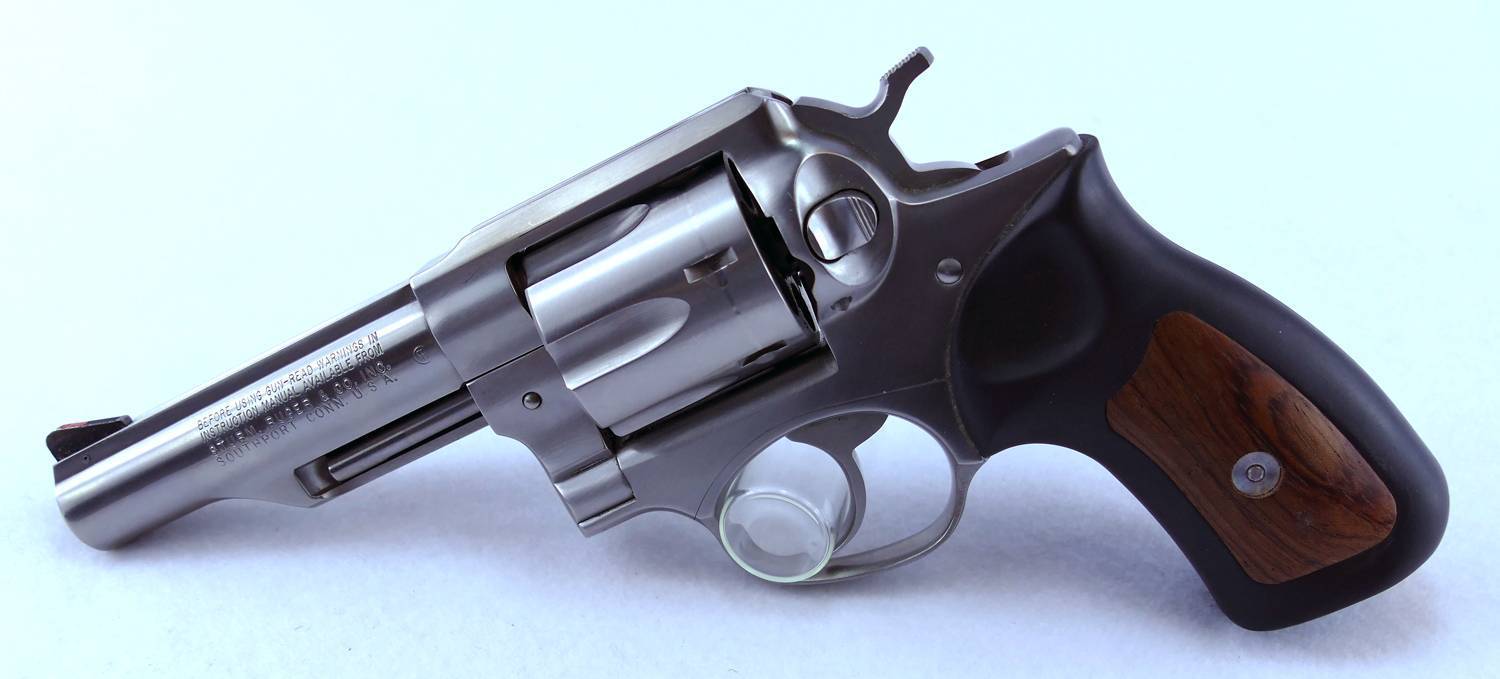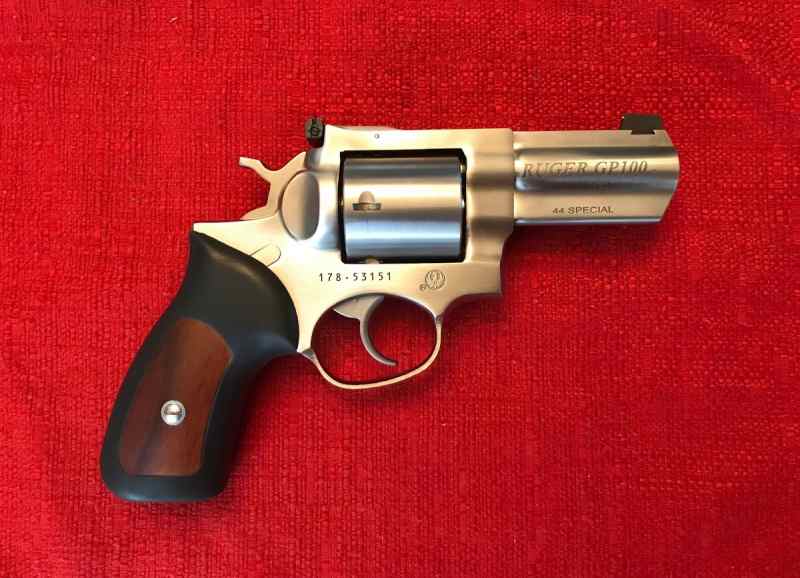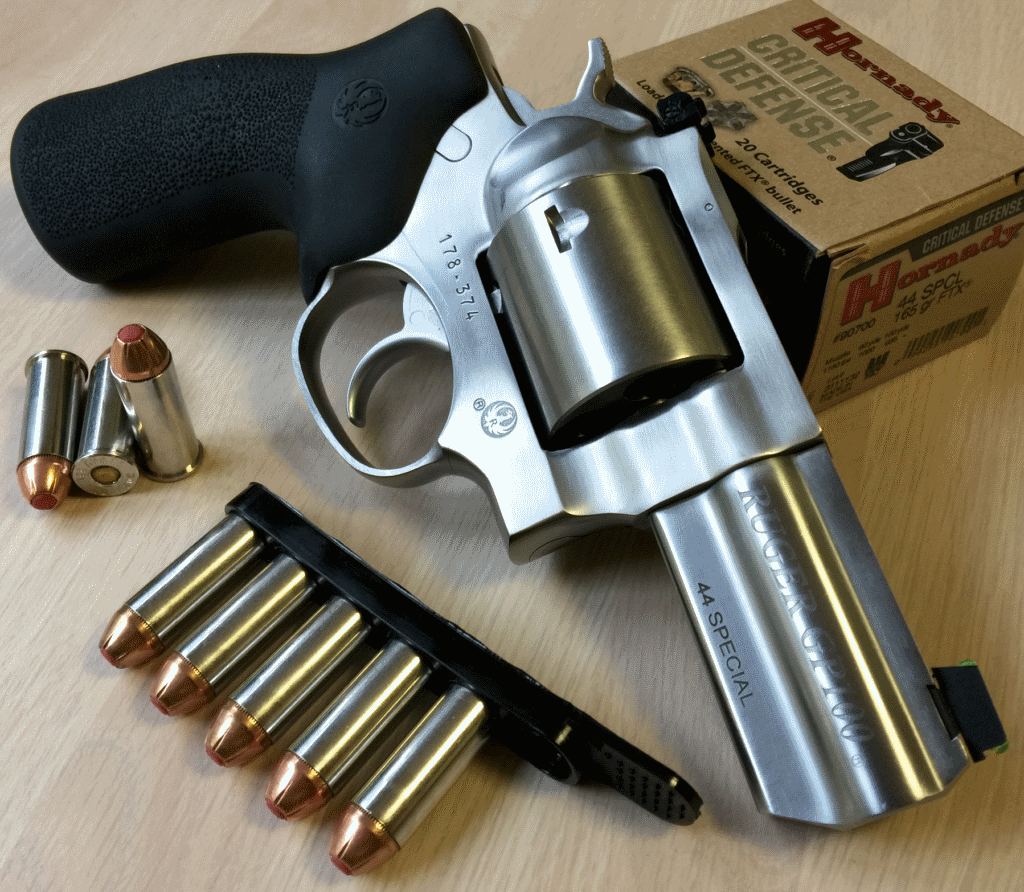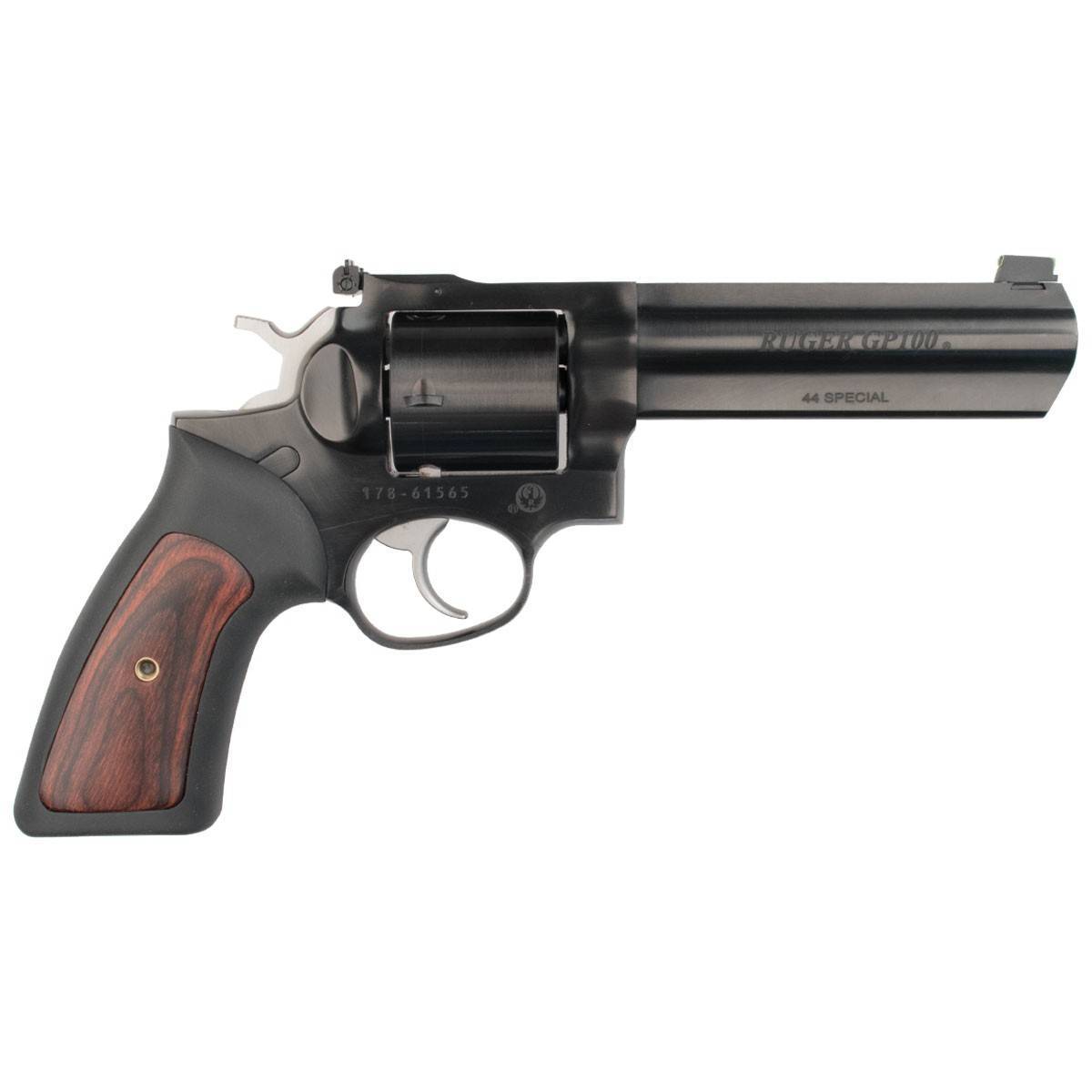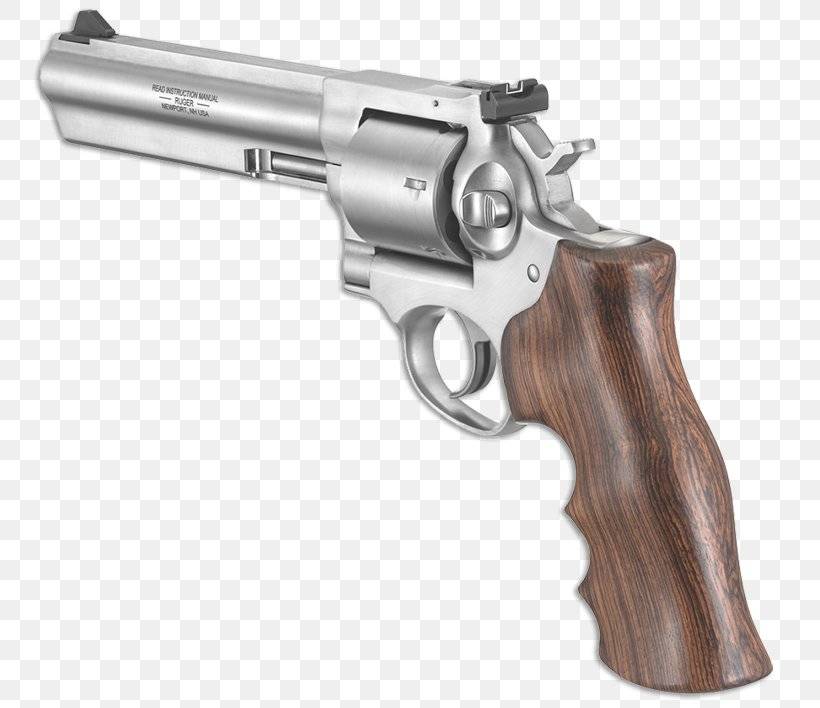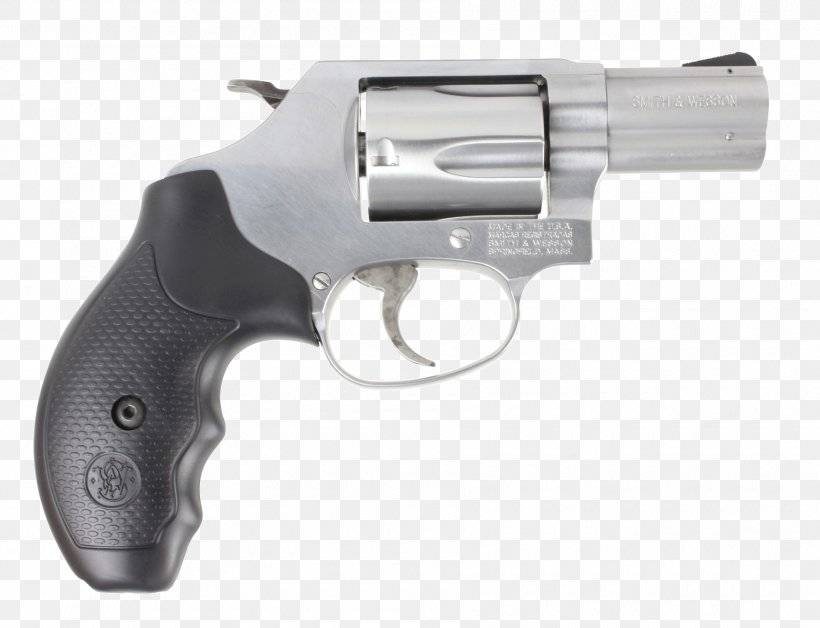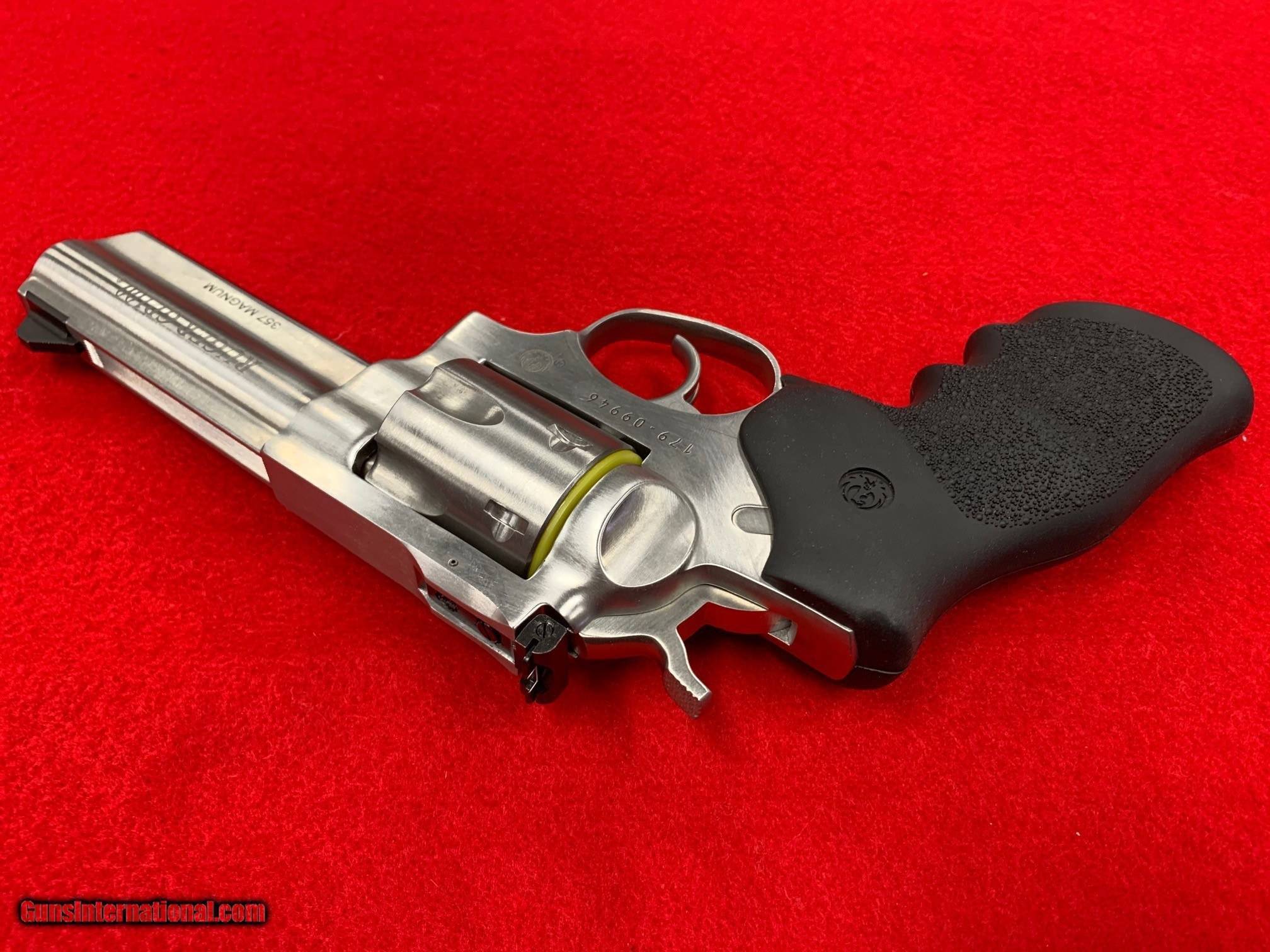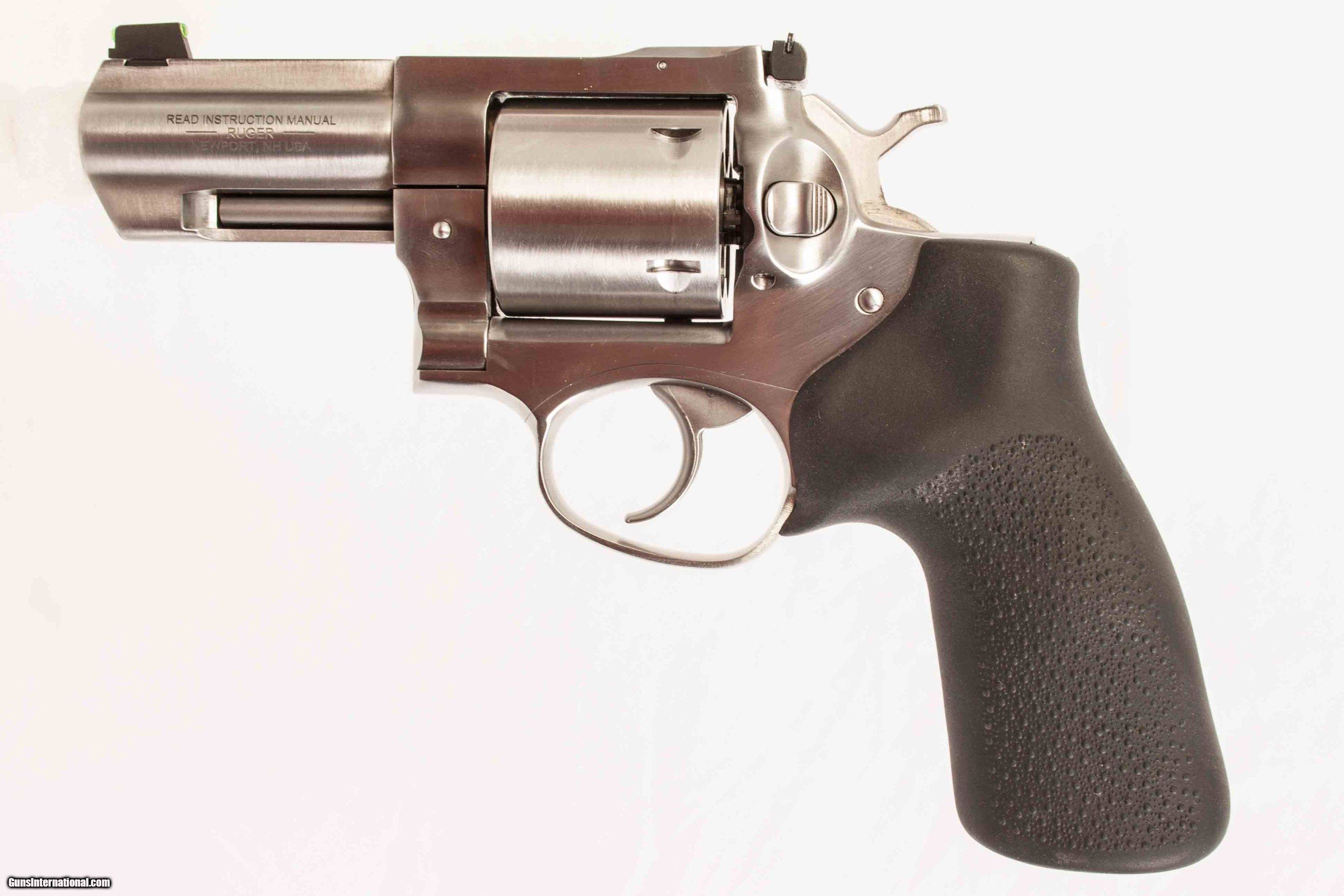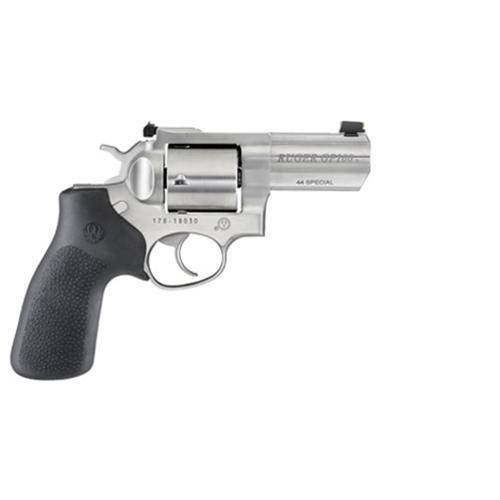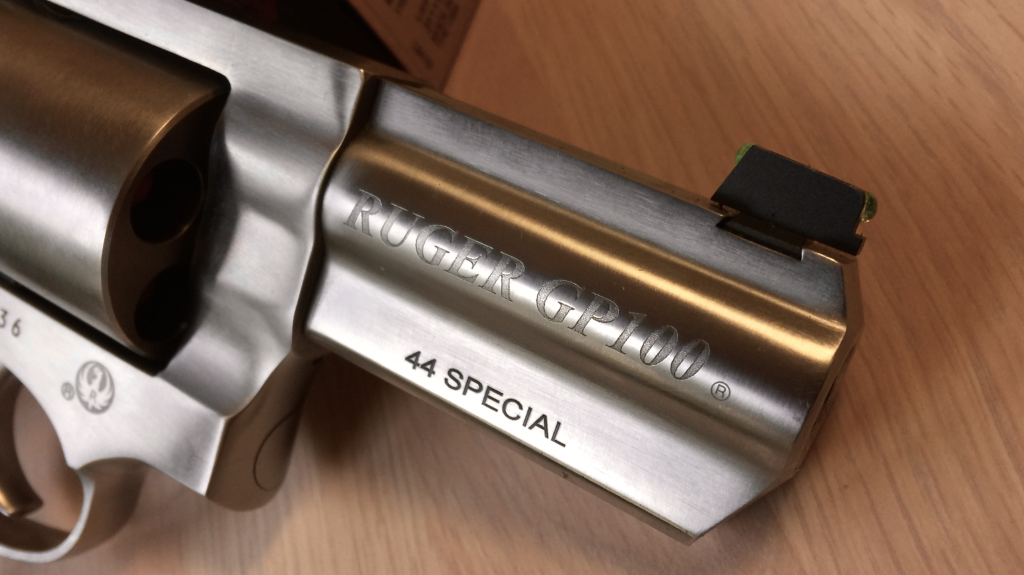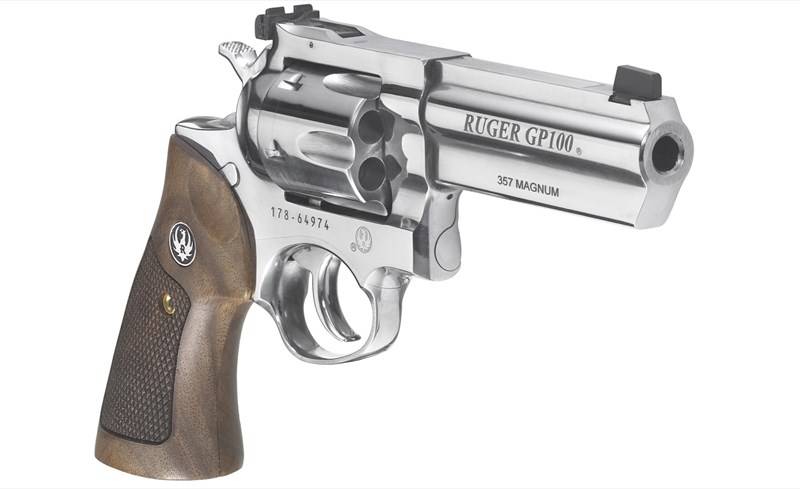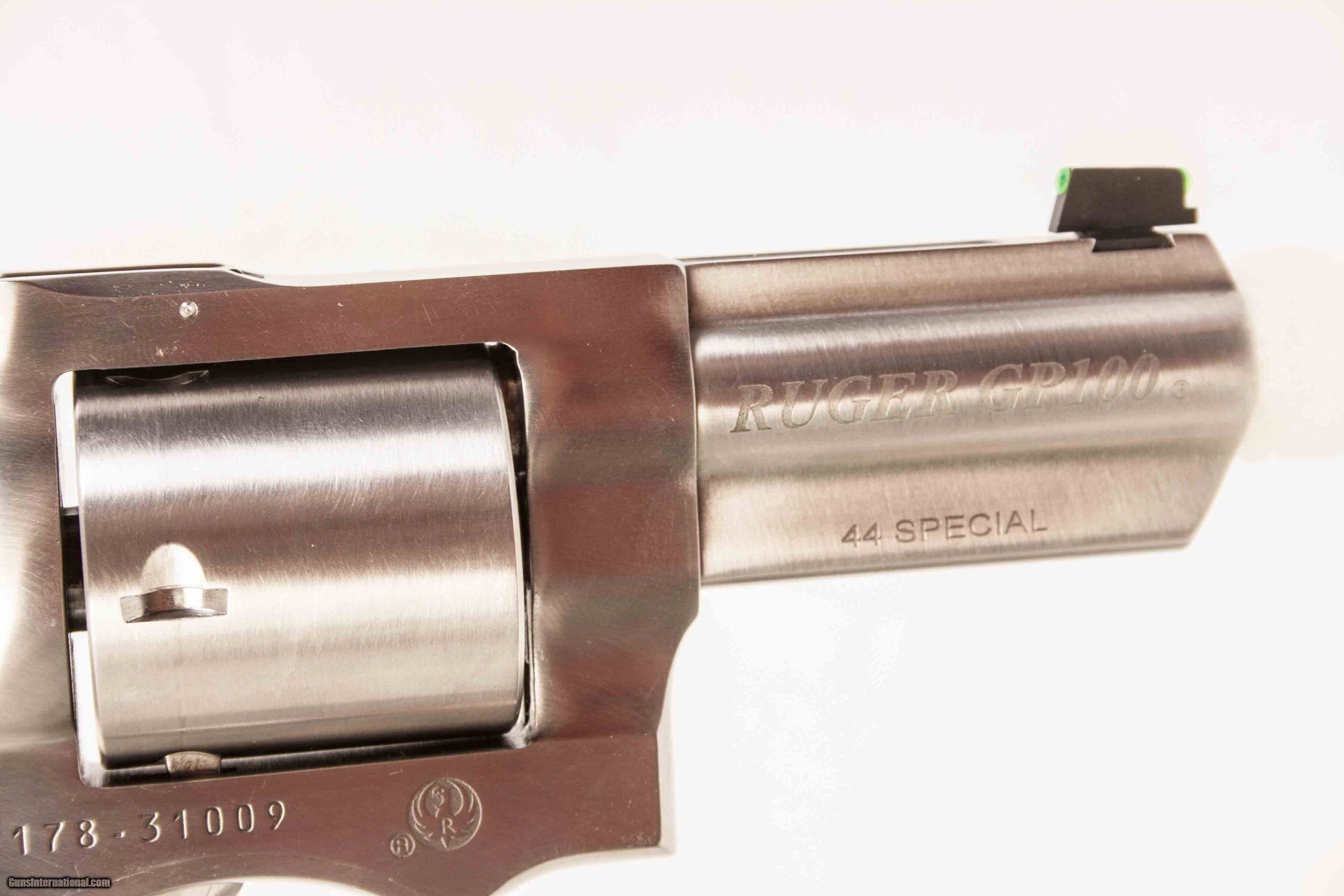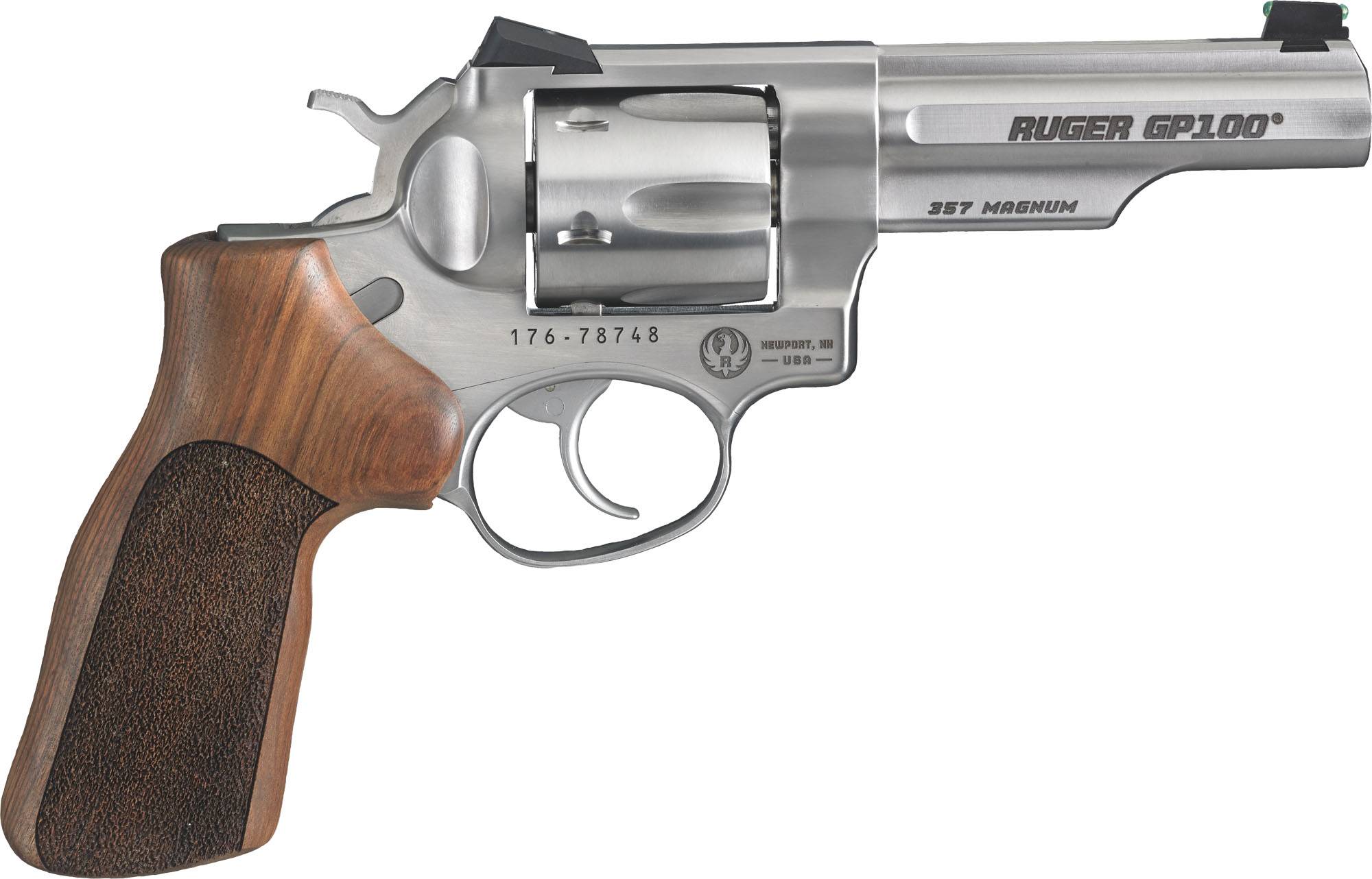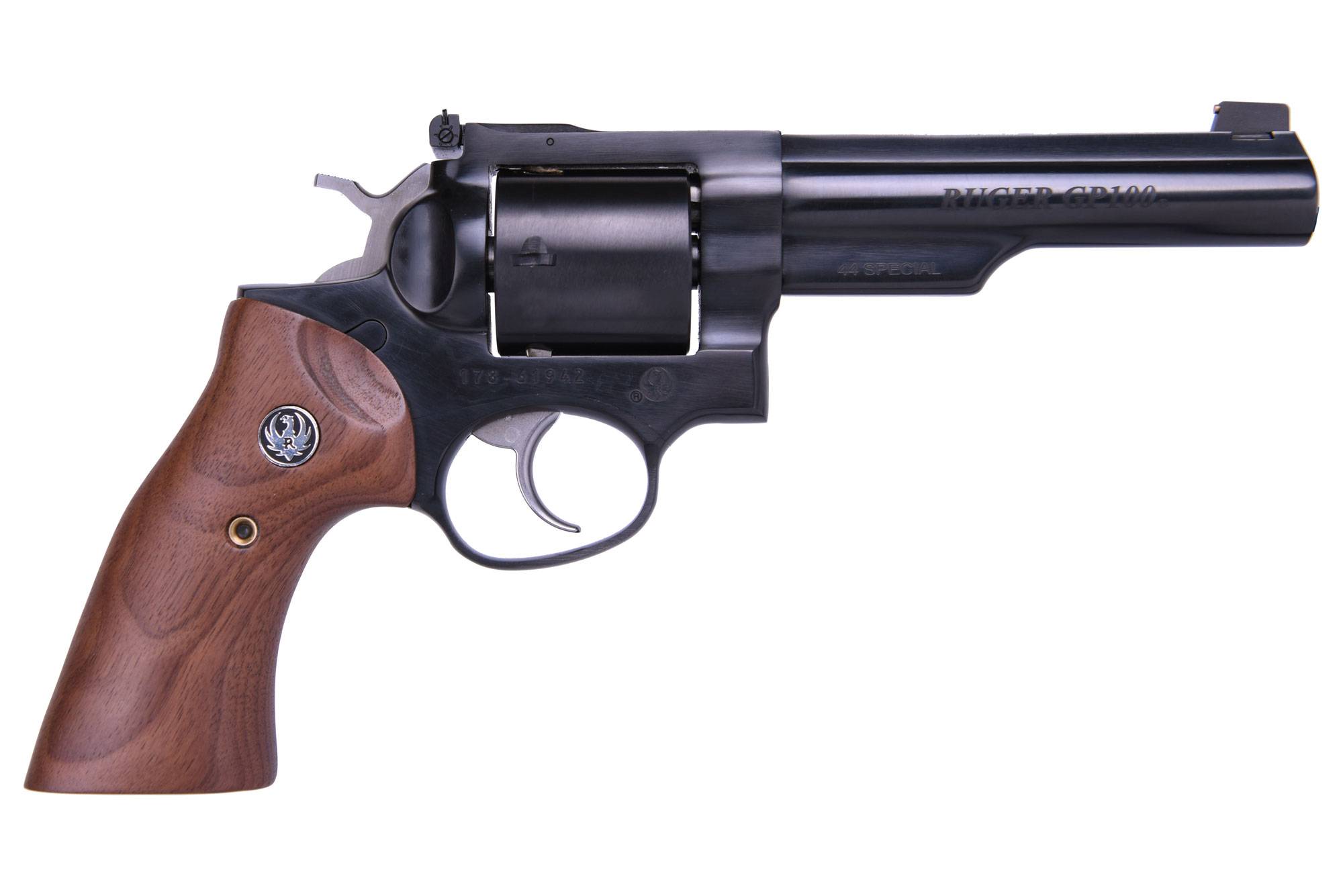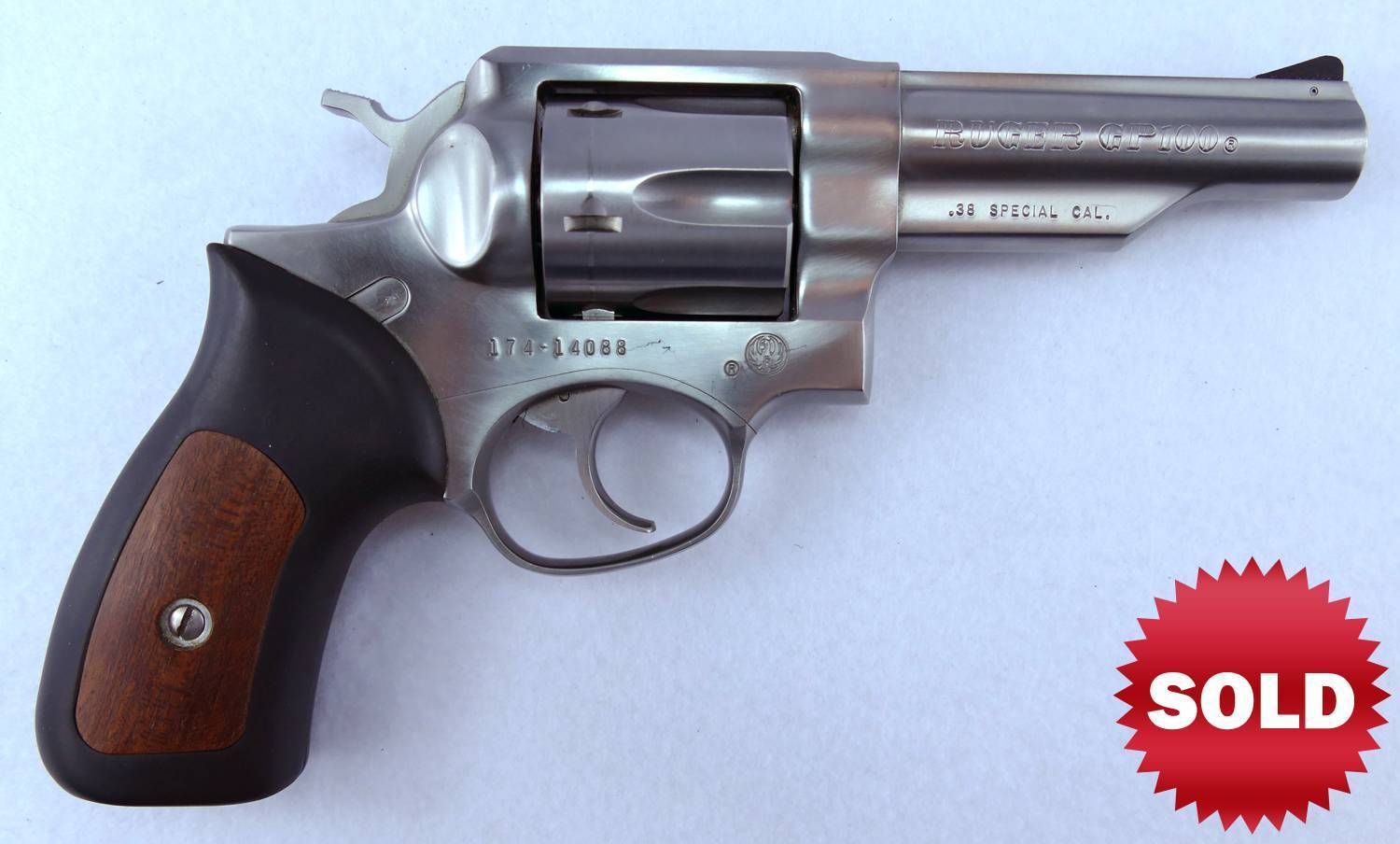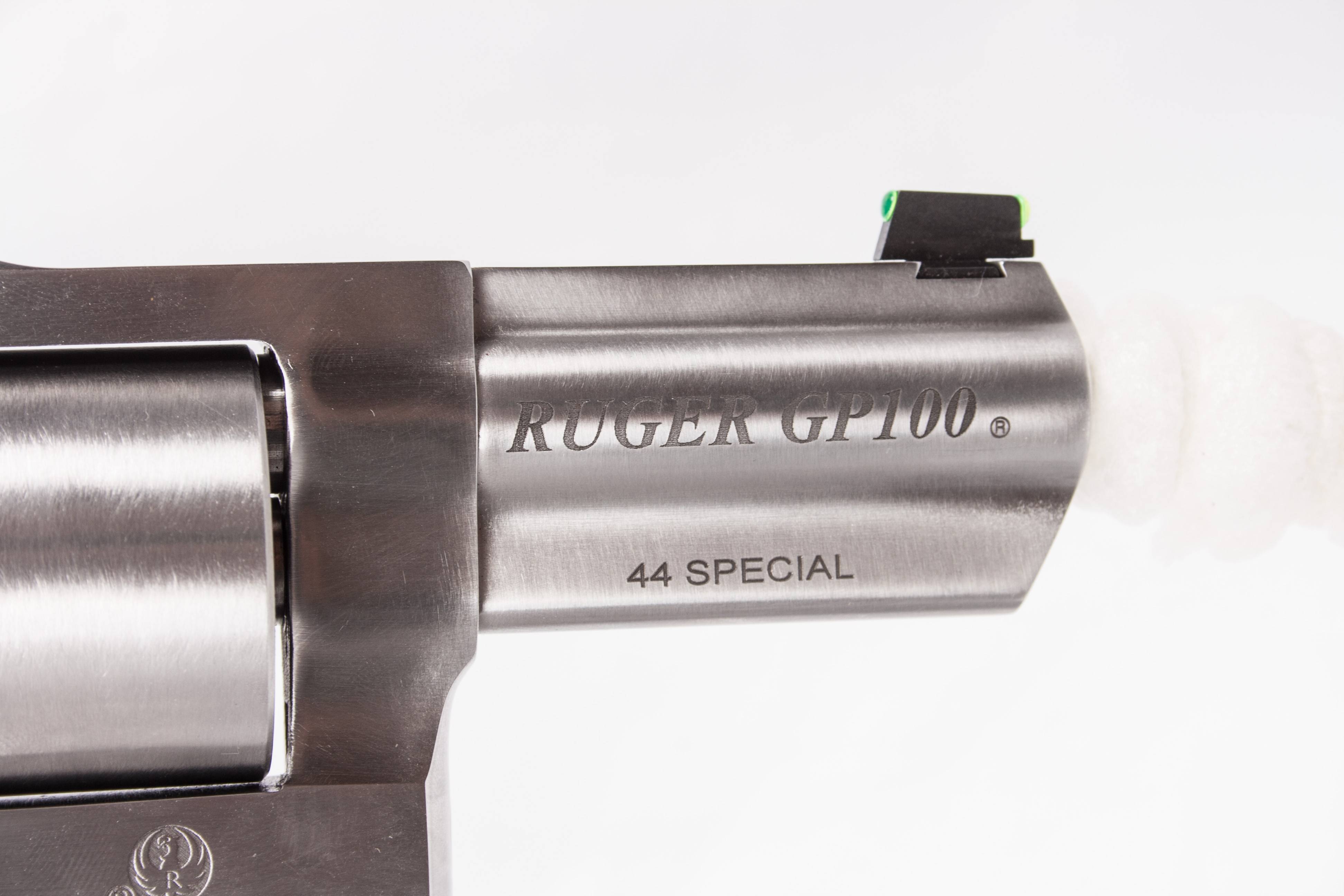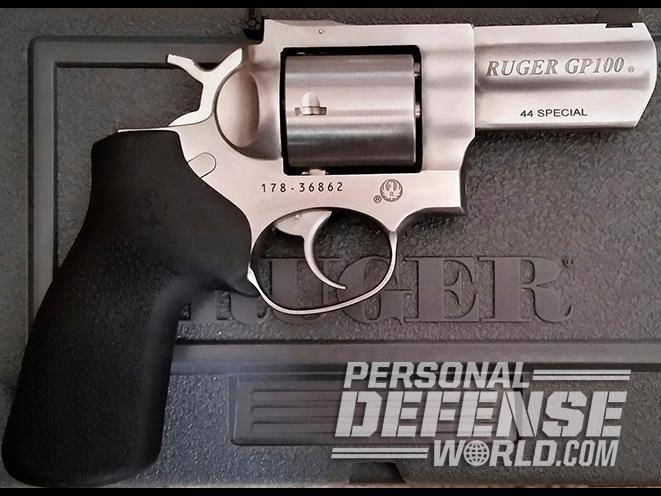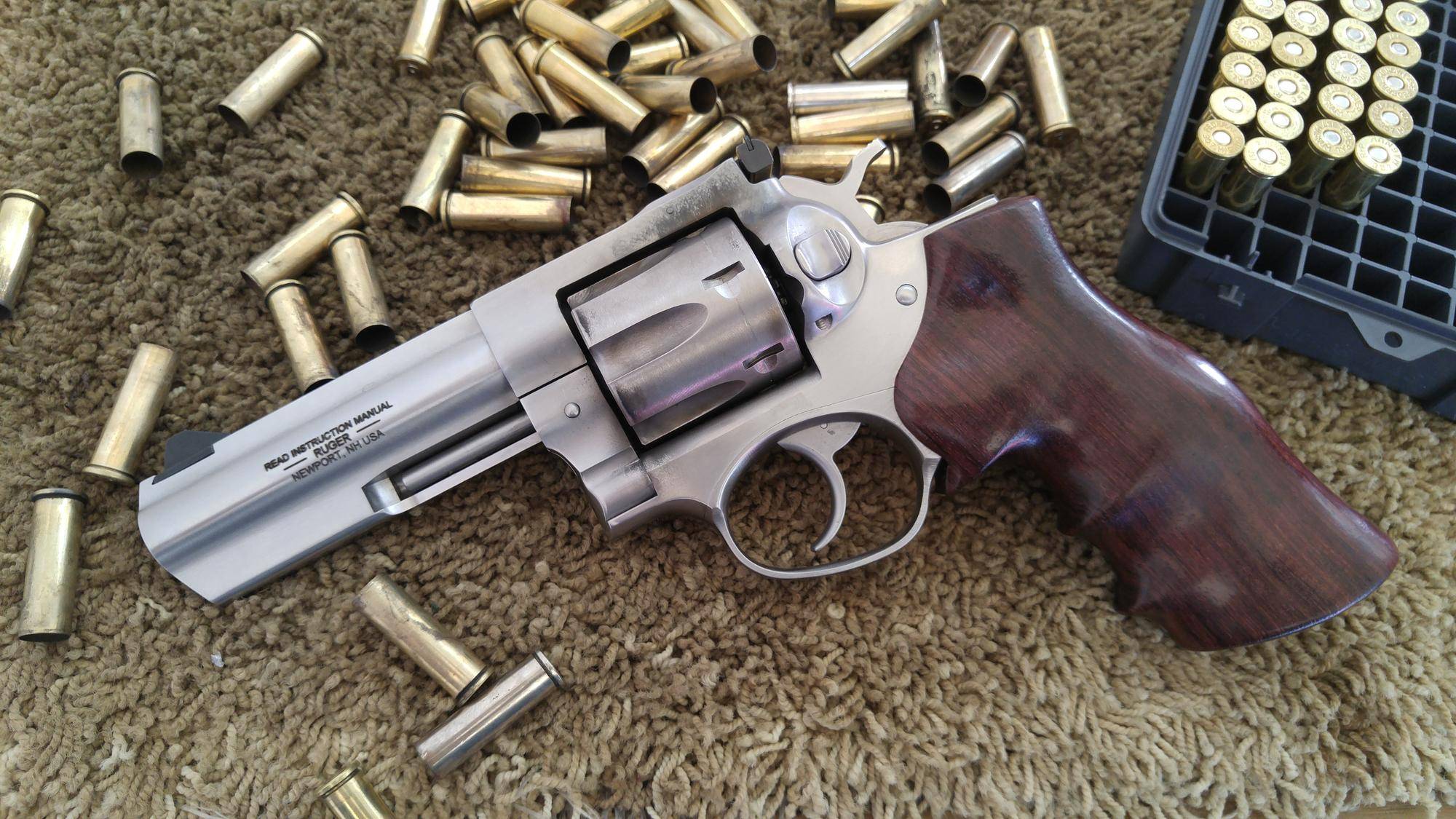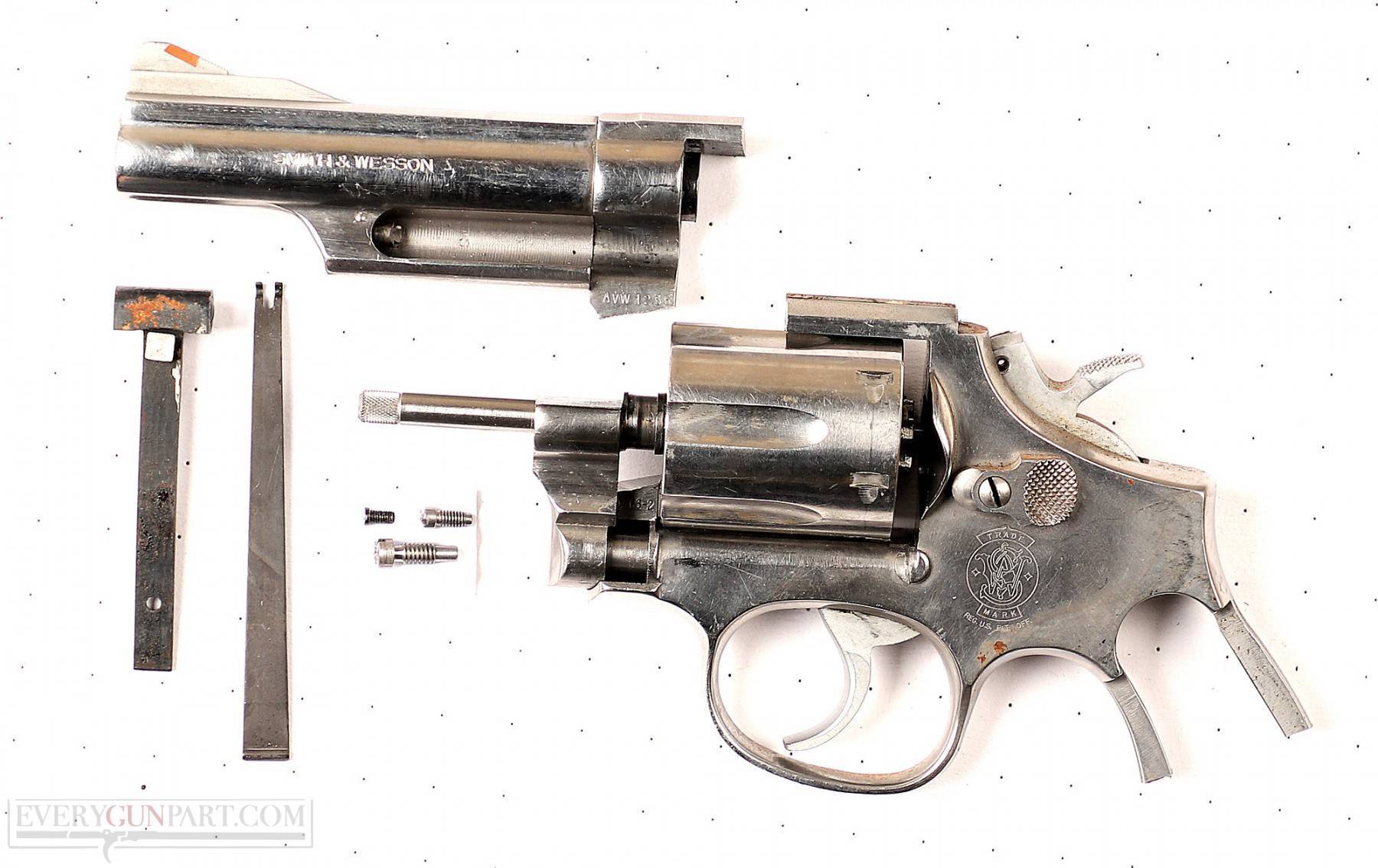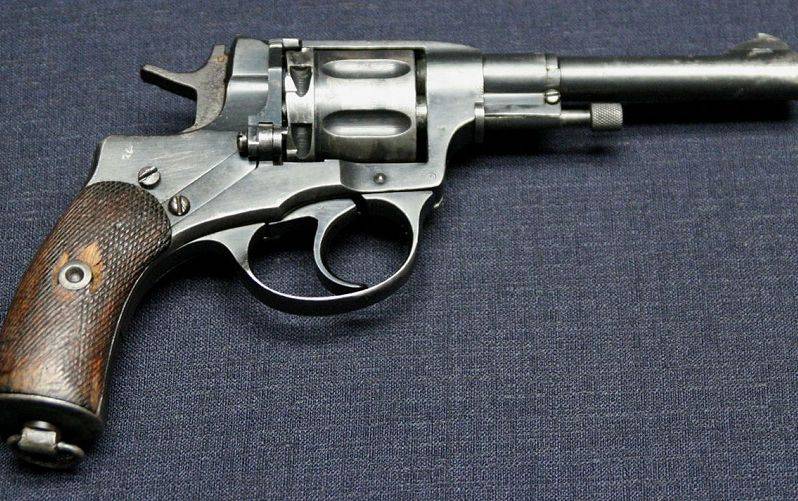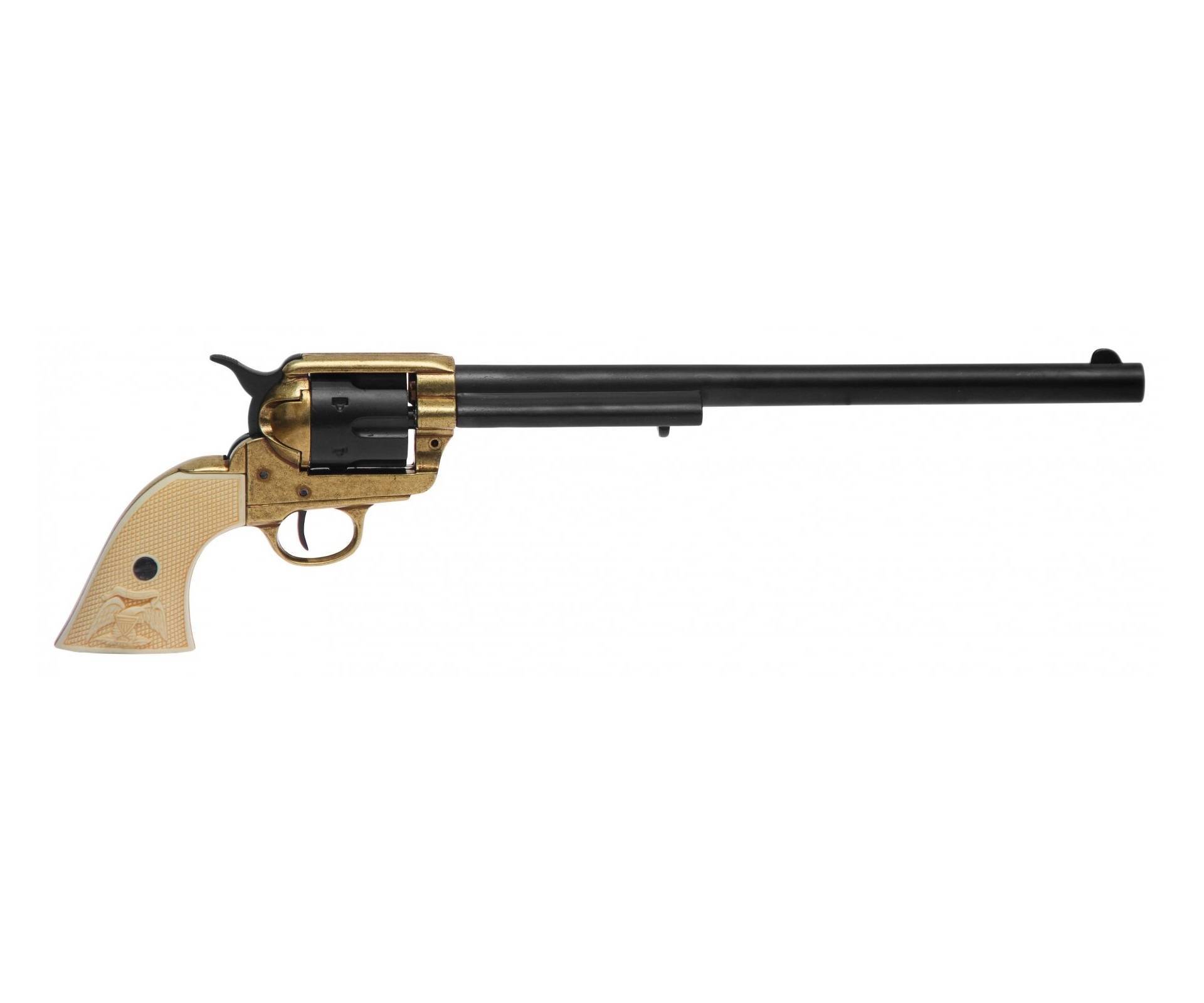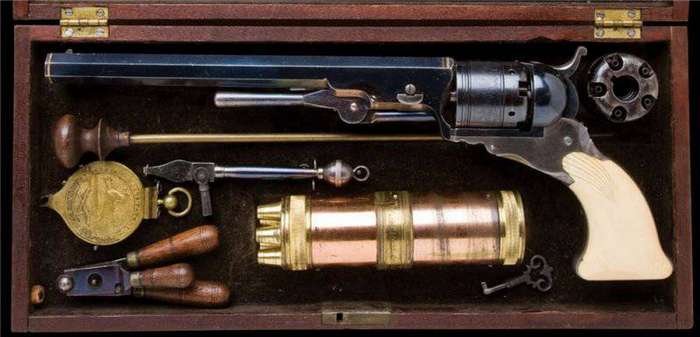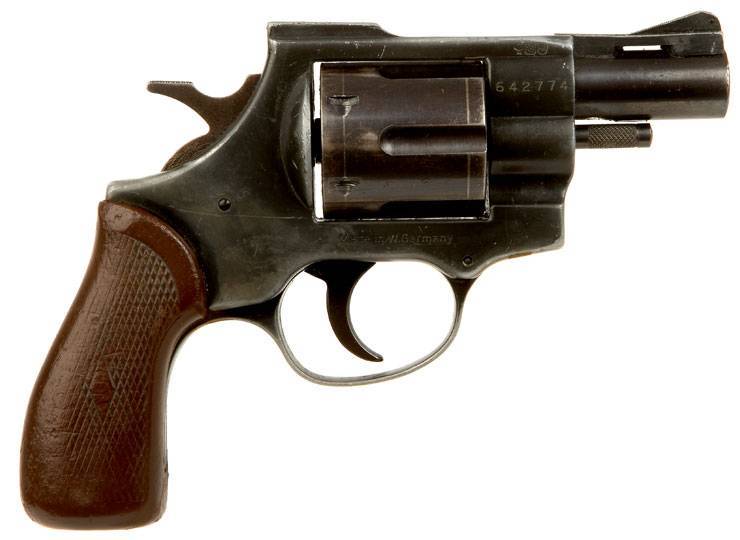Specifications
Major sub units of GP100 (KGP-141)
- Weight: 2.2 lbs (1000 g 4″, 1300 g 6″) The type of sights and length of ejection rod shroud affect the weight of the revolver. These are representative weights in the most common configurations.
- Barrel lengths: 3″ (76mm), 4.2″ (107mm), 5″ (127mm), and 6″ (152mm). The run of 5″ GP100 revolvers was made for the distributor, Davidson’s.
- Double Action. The GP100 may be fired by either cocking the hammer and subsequently pulling the trigger (a.k.a. Single Action), or by merely pulling the trigger when the hammer is not cocked.
- Maximum effective range: 55 to 110 yards (50 to 100 meters) depending on barrel length, cartridge load, and additional optical sights. Projectiles from this weapon can still be dangerous up to several thousand yards from the muzzle under optimum conditions. The quoted range is more a function of the useful range of a typical handgun than a statement of the maximum lethal range of the projectiles.
- 5-Shot .44 Special
- 6-Shot .357 Magnum and .38 Special, 10mm Auto
- 7-Shot .357 Magnum and .38 Special
- 7-Shot .327 Federal Magnum
- 10-Shot .22 Long Rifle
Users
- Greece: EKAM counter-terrorist unit of the Hellenic Police
- Serbia: Special Anti-Terrorist Unit.
- United Kingdom: Royal Ulster Constabulary officers were issued the 2.75-inch model chambered in .357 magnum until the adoption of 9mm Glock 17 and 19 pistols.
- United States: Used by some NYPD officers. The .357 magnum, 4-inch barreled model was issued by the United States Border Patrol to its patrol agents as well as to the uniformed officers of the former U.S. Immigration and Naturalization Service up until the early 1990s and used until both agencies switched to .40 caliber semi-automatic pistols. Also issued to armed prison guards.
References
Wilson, R. L.; G. Allan Brown (2008). Ruger & His Guns: A History of the Man, the Company and Their Firearms. Book Sales, Inc. ISBN 978-0-7858-2103-8..mw-parser-output cite.citation{font-style:inherit}.mw-parser-output .citation q{quotes:”\”””\”””‘””‘”}.mw-parser-output .id-lock-free a,.mw-parser-output .citation .cs1-lock-free a{background:url(“//upload.wikimedia.org/wikipedia/commons/thumb/6/65/Lock-green.svg/9px-Lock-green.svg.png”)no-repeat;background-position:right .1em center}.mw-parser-output .id-lock-limited a,.mw-parser-output .id-lock-registration a,.mw-parser-output .citation .cs1-lock-limited a,.mw-parser-output .citation .cs1-lock-registration a{background:url(“//upload.wikimedia.org/wikipedia/commons/thumb/d/d6/Lock-gray-alt-2.svg/9px-Lock-gray-alt-2.svg.png”)no-repeat;background-position:right .1em center}.mw-parser-output .id-lock-subscription a,.mw-parser-output .citation .cs1-lock-subscription a{background:url(“//upload.wikimedia.org/wikipedia/commons/thumb/a/aa/Lock-red-alt-2.svg/9px-Lock-red-alt-2.svg.png”)no-repeat;background-position:right .1em center}.mw-parser-output .cs1-subscription,.mw-parser-output .cs1-registration{color:#555}.mw-parser-output .cs1-subscription span,.mw-parser-output .cs1-registration span{border-bottom:1px dotted;cursor:help}.mw-parser-output .cs1-ws-icon a{background:url(“//upload.wikimedia.org/wikipedia/commons/thumb/4/4c/Wikisource-logo.svg/12px-Wikisource-logo.svg.png”)no-repeat;background-position:right .1em center}.mw-parser-output code.cs1-code{color:inherit;background:inherit;border:inherit;padding:inherit}.mw-parser-output .cs1-hidden-error{display:none;font-size:100%}.mw-parser-output .cs1-visible-error{font-size:100%}.mw-parser-output .cs1-maint{display:none;color:#33aa33;margin-left:0.3em}.mw-parser-output .cs1-subscription,.mw-parser-output .cs1-registration,.mw-parser-output .cs1-format{font-size:95%}.mw-parser-output .cs1-kern-left,.mw-parser-output .cs1-kern-wl-left{padding-left:0.2em}.mw-parser-output .cs1-kern-right,.mw-parser-output .cs1-kern-wl-right{padding-right:0.2em}
- ^ Peterson, Philip. Gun Digest Book of Modern Gun Values: The Shooter’s Guide to Guns 1900 to Present (16th ed.). p. 242.
- ^
- ^ Sweeney, Patrick (2007). Gun Digest Book of Ruger Pistols and Revolvers. Iola, Wisconsin: Gun Digest Books. pp. 172–174. ISBN 978-0-89689-472-3.
- ^
- ^ Former I&NS Special Agent
- ^ Former Border Patrol Agent
Описание и особенности
GP100 была эволюцией ранее револьвера Ruger двойного действия, в шестерке безопасности . Он был введен в 1985 году в качестве второго поколения Ruger двойного действия, с открытыми молотками револьверы , предназначенные для замены Ruger в Безопасность- / Сервис- / Speed-Six линии . Это было сделано сильнее с намерением стрелять неограниченное количество полной мощности .357 Magnum раундов. Первое значительное изменение было введено с Ruger Redhawk и участвует новый механизм блокировки с помощью рычага на кране , а не использовать конец выталкивающего стержня для фиксации. Еще одно изменение было форма рамы. Традиционные револьверных кадры были подвержены металл в передней и задней части ручки, с рамой , определяющей форму захватов. Это означало , что иметь круглую стыковой скрывала кэрри версию и квадратный стыковой кобуры или целевой вариант того же пистолета , как правило , означает , имеющий две различные формы кадра. Серии GP100, вместо этого, используется небольшой прямоугольный «колышек» сцепление достаточно большой , чтобы вложить пружину молотка и стойки. Рукоятки может затем быть любой формы , желательно, до тех пор , как они были достаточно большими , чтобы приложить колышек. Это не было нововведением того , как был использован Dan Wesson и, до некоторой степени, High Standard револьверов , которые предшествовавших GP100. Патент Dan Wesson ( ) был выдан в 1972 году , и патент Ruger ( в ) был выдан в 1986 году.
GP100 разделяет замок крана из Redhawk, который впоследствии был использован в небольшом кадре SP101 револьвера. Все эти модели используют ту же толщину, на твердую раме и двойной запирающей системе, которая используется в тяжелой .44 Magnum. Из-за этих особенностей, серия GP100 широко описывается как один из самых сильных средних каркасных револьверов когда-либо сделанных.
GP100 выпускается в .357 Magnum , .38 Special , .22 Long Rifle , .44 Special , 10мм Auto , и .327 Federal Magnum калибров. Доступные Barrel длины 3″ (76мм), 4,2″ (107 мм) и 6″ (152 мм) с полным или частичным underlugs длины. Вороненой стали или из нержавеющей стали отделки доступны, с номерами из нержавеющей модели , которым предшествует „К“. The стрельбе контактные из gp100 установлено внутри рамы. передача бар в gp100 подключен непосредственно к триггеру . Строка переноса должна присутствовать между молотом и ударником для того , чтобы картридж для стрельбы. Строка передачи только предполагает требуемое положение , когда курок полностью назад. модели gP100 доступны с фиксированными или регулируемыми прицелами . модели с фиксированным смотровыми обозначаются номер суффикса модели «F». когда цилиндр закрыт , а пистолет в момент выстрела, цилиндр кран заблокирован в рамку в передней и задней части крана и с помощью цилиндрического замка в нижней части отверстия крана. GP100 разбирает на три основные модули , имеющими только ограниченное использование инструментов. Это позволяет пользователь легко чистые Револьвер после стрельбы. Конструкция пистолета исключает необходимость в рамке «sideplate», особенность , которая способствует репутации GP100 для прочности.
Models
KGP-141 and KGP-160 .357 Magnum revolvers
| Catalog Number | Caliber | Barrel Length | Finish | Sights | Weight | Shroud |
|---|---|---|---|---|---|---|
| GP-141 | .357 Mag. | 4″ | Blued | Adjustable | 41 oz | Full |
| GP-160 | .357 Mag. | 6″ | Blued | Adjustable | 43 oz | Short |
| GP-161 | .357 Mag. | 6″ | Blued | Adjustable | 46 oz | Full |
| GPF-331 | .357 Mag. | 3″ | Blued | Fixed | 36 oz | Full |
| GPF-340 | .357 Mag. | 4″ | Blued | Fixed | 37 oz | Short |
| GPF-341 | .357 Mag. | 4″ | Blued | Fixed | 38 oz | Full |
| KGP-141 | .357 Mag. | 4.2″ | Stainless | Adjustable | 41 oz | Full |
| KGP-151 | .357 Mag. | 5″ | Stainless | Adjustable | 42 oz | Full |
| KGP-160 | .357 Mag. | 6″ | Stainless | Adjustable | 43 oz | Short |
| KGP-161 | .357 Mag. | 6″ | Stainless | Adjustable | 46 oz | Full |
| KGPF-330 | .357 Mag. | 3″ | Stainless | Fixed | 35 oz | Short |
| KGPF-331 | .357 Mag. | 3″ | Stainless | Fixed | 36 oz | Full |
| KGPF-340 | .357 Mag. | 4″ | Stainless | Fixed | 37 oz | Short |
| KGPF-341 | .357 Mag. | 4″ | Stainless | Fixed | 38 oz | Full |
| KGPF-840 | .38 | 4″ | Blued | Fixed | 37 oz | Short |
| KGPF-841 | .38 | 4″ | Blued | Fixed | 38 oz | Full |
| GPNY | .38 | 3″ & 4″ | Stainless | Fixed | 36~37 oz | Full |
| KGP-4327-7 | .327 Fed. Mag. | 4.2″ | Satin Stainless | Adjustable | 40 oz | Full |
| 1757 | .22 Long Rifle | 5.5″ | Satin Stainless | Adjustable | 42 oz | Short |
| 1761 | .44 Special | 3″ | Satin Stainless | Adjustable | 36 oz | Full |
Caliber: .357 Magnum GP100s handle all .357 Magnum factory loads and accept factory .38 Special cartridges. The .357 Magnum, four inch barreled model was standard issue to uniformed officers of the former U.S. Immigration and Naturalization Service as well as Patrol Agents of the U.S. Border Patrol until both agencies adopted .40 caliber semi-automatic pistols.
Not on CA DOJ approved list
Special design for the New York City Police Department in .38 with a spurless hammer, double-action only. Never issued to service officers. Ruger stainless double action only Service-Six revolvers chambered in .38 Special were issued from July 1987 until approximately 1992, when 9mm semi-automatics were phased in. Some officers still carry the stainless spurless Ruger and Smith & Wesson revolvers by choice and are being phased out as they retire.
Description and features
The GP100 was an evolution of an earlier Ruger double-action revolver, the Security Six. It was introduced in 1985 as a second generation of the Ruger double-action, exposed-hammer revolvers intended to replace Ruger’s Security-/Service-/Speed-Six line. It was made stronger with the intent to fire an unlimited number of full-power .357 Magnum rounds. The first significant change was introduced with the Ruger Redhawk and that involved a new locking mechanism with a lever on the crane rather than using the end of the ejector rod to lock. Another change was the shape of the frame. Traditional revolver frames had exposed metal at the front and rear of the grips, with the frame determining the shape of the grips. This meant that to have a round butt concealed carry version and a square butt holster or target version of the same gun usually meant having two different frame shapes. The GP100 series, instead, used a small rectangular “peg” grip large enough to enclose the hammer spring and strut. The grips could then be any shape desired, as long as they were large enough to enclose the peg. This was not a new innovation having been used by Dan Wesson and, to some degree, by High Standard revolvers that predated the GP100. The Dan Wesson patent () was granted in 1972 and Ruger’s patent () was granted in 1986.
The GP100 shares the crane lock from the Redhawk that was later used in the small frame SP101 revolver. All of these models use the same thickness on the solid frame and double latching system as used on the heavy .44 Magnum. Because of these features, the GP100 series is widely described as one of the strongest medium frame revolvers ever made.
The GP100 is manufactured in .357 Magnum, .38 Special, .22 Long Rifle, .44 Special, 10mm Auto, and .327 Federal Magnum calibers. Available Barrel lengths are 3″ (76mm), 4.2″ (107mm) and 6″ (152mm) with partial or full length underlugs.Blued Steel or Stainless Steel finishes are available, with stainless model numbers preceded by a “K”. The Firing pin of the GP100 is mounted inside the frame. The Transfer bar of the GP100 is connected directly to the trigger. The transfer bar must be present between the hammer and the firing pin in order for the cartridge to be fired. The transfer bar only assumes the required position when the trigger is pulled completely rearward. GP100 models are available with fixed or adjustable sights. Fixed sight models are designated by a “F” suffix model number. When the cylinder is closed and the gun is at the point of firing, the cylinder crane is locked into the frame at the front and rear of the crane and by the cylinder lock at the bottom of the crane opening. The GP100 disassembles into three major modules with only limited use of tools. This allows the user to easily clean the revolver after shooting. The design of the gun eliminates the need for a frame “sideplate”, a feature which contributes to the GP100’s reputation for strength.
модели
| Номер каталога | калибр | Длина ствола | Конец | Достопримечательности | Вес | пелена |
|---|---|---|---|---|---|---|
| GP-141 | 0,357 Mag. | 4″ | вороненый | регулируемый | 41 унций | Полный |
| GP-160 | 0,357 Mag. | 6″ | вороненый | регулируемый | 43 унций | короткий |
| GP-161 | 0,357 Mag. | 6″ | вороненый | регулируемый | 46 унций | Полный |
| GPF-331 | 0,357 Mag. | 3″ | вороненый | Исправлена | 36 унций | Полный |
| GPF-340 | 0,357 Mag. | 4″ | вороненый | Исправлена | 37 унций | короткий |
| GPF-341 | 0,357 Mag. | 4″ | вороненый | Исправлена | 38 унций | Полный |
| КГП-141 | 0,357 Mag. | 4″ | нержавеющий | регулируемый | 41 унций | Полный |
| КГП-151 | 0,357 Mag. | 5″ | нержавеющий | регулируемый | 42 унций | Полный |
| КГП-160 | 0,357 Mag. | 6″ | нержавеющий | регулируемый | 43 унций | короткий |
| КГП-161 | 0,357 Mag. | 6″ | нержавеющий | регулируемый | 46 унций | Полный |
| KGPF-330 | 0,357 Mag. | 3″ | нержавеющий | Исправлена | 35 унций | короткий |
| KGPF-331 | 0,357 Mag. | 3″ | нержавеющий | Исправлена | 36 унций | Полный |
| KGPF-340 | 0,357 Mag. | 4″ | нержавеющий | Исправлена | 37 унций | короткий |
| KGPF-341 | 0,357 Mag. | 4″ | нержавеющий | Исправлена | 38 унций | Полный |
| KGPF-840 | +0,38 | 4″ | вороненый | Исправлена | 37 унций | короткий |
| KGPF-841 | +0,38 | 4″ | вороненый | Исправлена | 38 унций | Полный |
| GPNY | +0,38 | 3″ и 4″ | нержавеющий | Исправлена | 36 ~ 37 унций | Полный |
| КГП-4327-7 | 0,327 ФРС. Магнето | 4,2″ | сатин из нержавеющей | регулируемый | 40 унций | Полный |
| 1757 | +0,22 Long Rifle | 5,5″ | сатин из нержавеющей | регулируемый | 42 унций | короткий |
| 1761 | 0,44 Специальные | 3″ | сатин из нержавеющей | регулируемый | 36 унций | Полный |
Калибр: .357 Magnum GP100s обрабатывать все заводские нагрузки 0,357 Magnum и принять завод .38 Special картриджи. .357 Magnum, четыре дюйма стволом модель была стандартной проблемой для униформе сотрудников бывшего СШАСлужба иммиграции и натурализации, а также патрульные агенты СШАпогранслужбы пока оба агентства не приняли +0,40 калибра полуавтоматических пистолетов.
Не на CA ДЮ утвержден список
Специальный дизайн для Департамента полиции НьюЙорка в .38 с spurless молотком, только двойного действия. Никогда не выдается сотрудникам службы. Ruger нержавеющого только двойное действие Сервис-шесть револьверов камерные в .38 Special были выпущеныс июля 1987 года примерно до 1992, когда 9ммы полуавтоматический были поэтапно. Некоторые офицерыпрежнему несут нержавеющий spurless Ruger и Smith & Wesson Револьверов по выбору инастоящее время постепенно, как они выходятпенсию.

